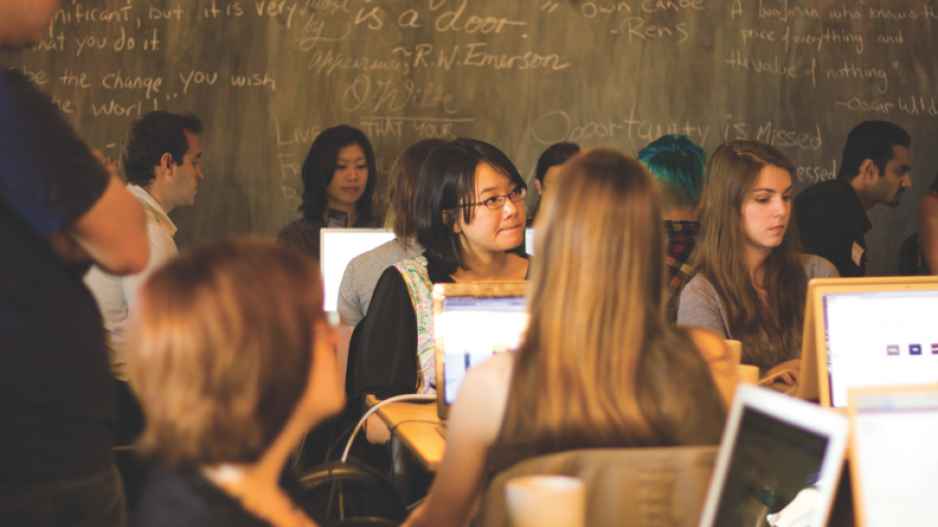The world’s first computer programmer was a woman. Ada Lovelace’s work on the never-realized Analytical Engine more than 170 years ago laid the groundwork for the technological revolution to come.
More than a century later, when the computer made the leap from fictional to bona fide, programming was still primarily the domain of women.
“Computer science, historically, if you go back decades, actually has reasonable participation of women, up to 30 per cent. In fact, if you go back to the creation of the computer, most programmers were women because it was somehow viewed as being like secretarial work,” says Lesley Shannon, an associate professor in the School of Engineering Science at Simon Fraser University (SFU) and the National Sciences and Engineering Council chair for women in science and engineering for B.C. and Yukon.
Then computers became less obscure, potentially even lucrative. Things changed.
“Then it shifted in perception and men came into the field, and now men dominate the field,” says Shannon.
In fact, even as women make some incremental gains in science, engineering and math, their numbers have actually decreased in recent years in technology.
Only nine per cent of the members of the Applied Science Technologists and Technicians of British Columbia are women.
In undergraduate computer science programs, just 14 to 18 per cent of students are female. In computer engineering, it’s worse, at only about one in 10.
“The numbers are bad,” Shannon says. “I would say there’s a historical aspect here where this was a man’s job – he built the machines.”
It’s been a dogged stereotype to ditch, despite efforts.
Five years ago, a simple tweet about teaching women to code brought Heather Payne, Melissa Sariffodeen, Laura Plant and Breanna Hughes together, and Ladies Learning Code was born.
The first workshop sold out in a day. Since then, the non-profit organization has expanded to 29 cities across the country, including Vancouver and Victoria. More than 25,000 women and girls have attended workshops.
“Overwhelming,” says Sariffodeen. “Our second workshop sold out in 30 seconds.”
Sariffodeen taught herself to code when she was 11 or 12. She spent her summers making websites and games.
“I took computer science in high school and did well but was never encouraged to pursue it further, despite doing well,” she says.
“We see it a lot in our programs with girls and teens – there’s a turning point where it’s no longer cool to be smart or good at science or math, and there’s drop-off then.”
Add to that a gender bias in technology toward boys and the lack of female role models and you have a gender gap, she says.
But things have changed since her early days in the industry, thanks to government and private-sector commitment to close the gap.
“I see it every day in our programs – more and more attendance, women changing careers and pursuing technology after having a positive interaction and exposure in our program,” she says.
At SFU, some very simple changes have had a huge impact, Shannon says. In the computer engineering department the percentage of female students jumped to 19 per cent from nine per cent in two years.
And that’s largely from changing the technology discussion.
“How you talk about these things has huge impacts in terms of the perception,” she says.
For a long time it was men who spoke about computer engineering, and their focus tended to be on building hardware.
“My spin is more about helping people solve their problems, as opposed to ‘It’s just about the technology,’” she says.
“Women tend to be more motivated by the ‘why,’ so anything we can do to help boost that aspect is good.
“The technology unto itself is not motivational.”
SFU is also taking an early aim at the next generation of students, with programs for middle-grade and high school girls such as Go Code Girl and Girls Get IT.
“Kids around 10 or 11 start deciding what they’re not going to do, so we want to get in and make sure they’re not saying no to computing because of some stereotypes,” Shannon says.
The Technovation program challenges students to design a social app that will help their community in some way. In just its second year, the program has produced some impressive results.
“You would be in awe of what these middle-school kids can come up with,” she says.
One group created a community app for their school that shows new students where local parks, the library and the community centre are. Another created a hiking app that determines if a hiker has enough time to complete the route before sundown. It also tracks hikers and provides an alert when they should turn around, so they aren’t stuck in the dark.
A high school group designed an app for Syrian refugees, to help familiarize them with currency, language, signs and other aspects of Canadian life.
“It’s not just about the code. It’s that holistic picture that girls find attractive, and it starts to take away this perception that all you do is type at a computer,” Shannon says. “It opens them up to being creative.”
Getting girls and women into technology is a boon not just to them but to tech, too, Shannon says.
“The more diverse a group is, the more innovative it is,” she says.




